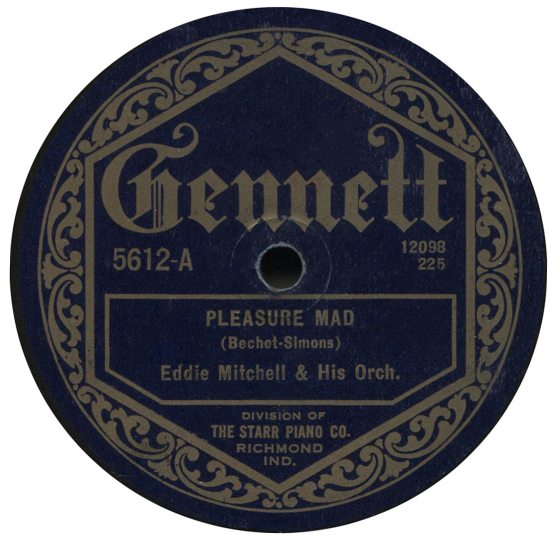
Here’s a sampling of some of the recent audio restorations that have been added to Radio Dismuke’s playlist. Brief information about the selections can be found following the recordings.
“Old Fashioned Love”
Clyde McCoy And His Orchestra
(Decca 509-A mx C 9960) April 25, 1935
“Azul”
Agustin Lara; vocal, piano
(Peerless 1383 mx 270 A) 1933
“Concha Nacar”
Agustin Lara; vocal, piano
(Peerless 1383 mx 268 A) 1933
“Tell Me Why You Smile Mona Lisa”
Victor Young And His Orchestra; Frank Munn, vocal
(Brunswick 6309) May 11, 1932
“Bring It On Down To My House”
Bob Wills And His Texas Playboys; Tommy Duncan, vocal
(Vocalion 03492 mx C 1500) September 30, 1936
“Mean Mama Blues”
Bob Wills And His Texas Playboys; Tommy Duncan, vocal
(Vocalion 03492 mx C 1495) September 30, 1936
“Jig In G”
Emilio Caceres And His Club Aguila Orchestra
(Victor 24614-B) April 4, 1934
“I’ll Be Blue Just Thinking Of You”
Buddy Blue, vocal
(Crown 3021-A mx 1015) September, 1930
“You’re All I Need”
Freddie Rose; vocal, piano
(Decca 523-A mx 39770) July 26, 1935
“I Love You From Coast To Coast”
Jack Shilkret And His Orchestra; Chick Bullock, vocal
(Melotone 7-02-14 mx 20375) December 9, 1936
Clyde McCoy’s version of “Old Fashioned Love” was both old-fashioned and modern when it was recorded in April 1935. By then, the song was already an “oldie,” having been written by James P. Johnson and Cecil Mack for the 1923 Broadway production Runnin’ Wild. The show, with an all-black cast, also introduced their song “The Charleston,” which sparked the mid-1920s Charleston dance craze. On the other hand, the closing passages of Clyde McCoy’s recording very much foreshadow the swing era, which, according to music historians, officially began four months later with Benny Goodman’s famous and highly successful engagement at the Palomar Ballroom.
Agustin Lara was a famous Mexican composer. The two haunting recordings here, in which he provides the vocal and accompanies himself on the piano, are of his own compositions. Both songs are well-known in the Spanish-speaking world but, for whatever reason, never really caught on in the United States.
“Tell Me Why You Smile Mona Lisa” is one of the relatively few popular German songs of the era recorded by American bandleaders. It is from the 1931 German film Der Raub der Mona Lisa/The Theft of the Mona Lisa and was written by Austrian composer Robert Stolz. Stolz is best remembered as a composer of operettas, but he also wrote for the film industry.
Bob Wills (along with Milton Brown) launched a new musical genre, western swing, in Fort Worth, Texas, during the early 1930s. This genre combined elements of country music with jazz and became extremely popular by the end of the decade, particularly in the Southwestern United States.
Jazz violinist Emilio Caceres was another musician who was extremely popular in Texas and, eventually, beyond in the 1930s. The band had a long-term engagement at and broadcasted from San Antonio’s Club Aguila. “Aguila” is Spanish for “eagle.” The club was owned by the Gephardt Chili Powder Company, which manufactured Gebhardt’s Eagle Brand Chili Powder, among other products, and introduced the wider world to another famous Texas invention, Tex-Mex cuisine.
Another Texan who made an impact on the musical world in the 1930s was Smith Ballew, recording here as “Buddy Blue,” a pseudonym frequently used on his recordings for labels other than the one that currently had the exclusive on issuing recordings under his own name.
I suspect, but can’t confirm, that Ballew is accompanied here by Joe Venuti on violin and Eddie Lang on guitar. Someone who has uploaded a copy of this recording to YouTube says in the upload notes that Joe Venuti was on this recording. However, I have not found any definite confirmation in any of my reference material. But Venuti and Lang did freelance with Crown Records’ in-house studio band and appeared on other Smith Ballew Crown recordings. Thus, I suspect that chances are pretty good that they are on this recording as well. Regardless, I think this is a very nice performance by Ballew and whoever the violin and guitar players might have been.
Freddie Rose provides another example of a famous composer accompanying himself on the piano – though the song he plays here was not one of his compositions but rather one co-written by Walter Jurmann and Kaper Bronisław, a songwriting team that was famous in Weimar-era Germany before they were forced to flee that country when Hitler’s National Socialists came to power. They eventually landed a long-term contract in the United States with the MGM film studio. “You’re All I Need” is a song they wrote for the 1935 MGM film Escapade.
In the 1920s Rose composed several jazz songs that became hits and also made a good number of vocal recordings for Brunswick. But, in the early 1930s, he moved to Nashville, Tennesee, where he began to increasingly focus on country music. He eventually became a music publisher and a major force in the country music industry.
Jack Shilkret was a successful bandleader and the younger brother of Nathaniel Shilkret, who headed up in-house bands for the Victor label.










